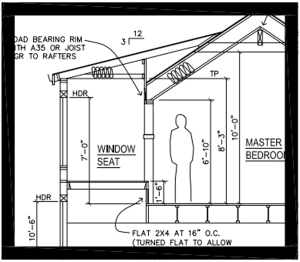Small comforts and perfect moments aren’t always planned
 I KNOW THERE IS A COTTAGE IN MY HOUSE. It’s there in all the ways my house lives like a smaller house. I’m really glad about that.
I KNOW THERE IS A COTTAGE IN MY HOUSE. It’s there in all the ways my house lives like a smaller house. I’m really glad about that.
I really like the way the bottom steps of our stairway double as seating when people are visiting in our foyer. And I like knowing exactly which are my favorite two windows to open when I need to cool the house with a cross breeze.
These are some of the tiny ways that my house makes it easy for me to live. Some of these accommodations are so very small as to not even come to mind.
Here’s one I recently noticed myself using: I can tell if someone is using the bathroom upstairs by walking down the hall next to the coat closet and listening for the tiny din of noise deep in the wall that is water running in pipes. It’s not that big a deal, but it is something that comes in handy now and then. More than that, it is undeniable evidence that my house and I “get” each other.
Because I’m in the middle of designing a new house for myself, I’ve tried to become better at noticing these things so I can recreate them in the new house. It’s easy to miss them. Despite the fact they are central to how we live those particular moments, we fall into them so easily that they just seem natural.
Winston Churchill said that we shape our buildings, and afterward they shape us. Smart fella. Happily, we humans are very good at adapting to these idiosyncrasies. We do what we can to get the important things right, and after that we simply learn to somehow live happily with the rest.
I know that some of these nuances can be planned into a house, but a huge amount are just random. For this reason, I suppose I’ll give myself a pass if I can’t control every effect of my house’s design. Still, I know I’ll be sad if some livable aspect of my old house doesn’t make it into the new one — all because I failed to notice it and plan accordingly. So I’m busy trying to notice them.
Another favorite: Right now we have a nifty technique for navigating in the dark in our bedroom. When leaving the bathroom to go to bed, the bathroom light will shine through the door onto the bedroom floor without shining up on the bed and disturbing anyone sleeping there. This allows for a quick survey of any obstacles (such as a sleeping dog) that might be in the path of travel before we turn off the light and creep to bed in the dark. It was a fluke that the light fixture and the doorway aligned this way in the first house, but now that I’m accustomed to the benefit, I’m making sure it will happen in the next one.
But my favorite idea is entirely new, and very cottage-like. I think it will be a hit. It’s the “dream window seat.”
 Imagine you have a chance to create a getaway spot in a remote corner of your house, away from everyone. It’s a sort of nest for yourself that no one will ever see, where you get to keep however many pillows plumped up or squished together as you please, with a comforter in a big pile. There’s a little shelf to the side to hold a delightful funky old reading lamp and a stack of favorite books. Such a place would be quite the spot for taking in a view or reading or napping. Or all three. The fact that it’s hidden away from everyone lets you set it up however you want — for your own comfort and needs, with no need to conform to anybody else’s expectations.
Imagine you have a chance to create a getaway spot in a remote corner of your house, away from everyone. It’s a sort of nest for yourself that no one will ever see, where you get to keep however many pillows plumped up or squished together as you please, with a comforter in a big pile. There’s a little shelf to the side to hold a delightful funky old reading lamp and a stack of favorite books. Such a place would be quite the spot for taking in a view or reading or napping. Or all three. The fact that it’s hidden away from everyone lets you set it up however you want — for your own comfort and needs, with no need to conform to anybody else’s expectations.
Does that change how you think about this space? You bet it does. Like when you go to a cabin and are happy you get to live in the casual way of a cabin.
This sort of getaway space was proposed in print by my favorite architectural writer, Christopher Alexander. He did it as an exercise to point out how our thinking will change when we are completely free to respond to what we want without concern about meeting some “standard” we think is expected of us and our houses. But as soon as I read it, I knew I wanted to actually have such a space for my own. So I’m adding it to my next house.
It will be around the corner in the master bedroom and will have a view. It’s sort of a window seat, but more like a “getaway alcove.” I plan on adding a heavy curtain to be able to cordon it off from the bedroom, and to control light and heat and cooling. It’s wide enough for two, and long enough to fully stretch out in. After a hot day we may seek the cool of the night by sleeping there. The curtain would seal us off from the warm bedroom and let us sleep with the two big windows open as if we were on a “sleeping porch” complete with screens, like houses had a hundred years ago for use after warm days.
There’s another side to this window seat that is revealed when the seasons change. During winter storms, we’ll close the blinds against the beating of the rain and wind and snuggle up together. I heard the word “Snug-aree” used to describe a cozy sort of place built into a house that feels especially protected from storms. The contrast of the storm lashing the windows and the warm, soft comfort of one’s dearly beloved should be very enjoyable.
Of course you don’t need a special window seat — or a getaway-alcove — to experience that kind of perfect moment when you’re snuggled up in bed during a storm, deeply thankful for the feeling of shelter against the cold night provided by your house, your bed, your blankets, your significant other. Those moments are available to you right now, within your own homes.
There is a cottage in your house. Be really glad about that.
Steve McKee is a Benicia architect specializing in residential design. He can be reached on the Web at www.smckee.com or at 707-746-6788.






Leave a Reply